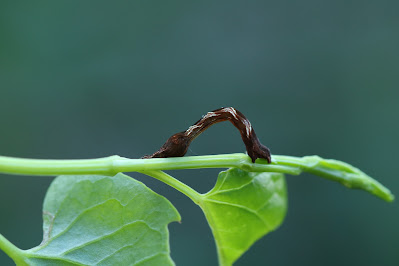The first inchworm found in Baltic amber was discovered in 2019 and was given the name Eogemeter. It was estimated to date back 44 million years ago! So, they have been around a very long time. Currently there are approximately 24,000 species of inchworms found Worldwide, 1400 of which live in North America, there is no shortage of these fascinating caterpillars. They belong to the family of moths called the Geometer moths. This name is derived from the Latin word geometra and translates loosely into “earth measurer.” Which is also a descriptive term for their unique movement. They may be green, gray or a shade of brown, with some species being nearly black. Some may have spots, or stripes, but all are masters of camouflage. These small, thin caterpillars resemble twigs and blend in well with their environment. When disturbed many species will bungie jump from their vantage point via a piece of silk string they release. This silk string will harden, allowing the caterpillar to climb back up to continue feeding once danger has passed. Some parasitic wasps, however, are aware of the trickery of these caterpillars. They can locate the silk line and either reel up a desperate caterpillar or maneuver themselves down the silken line to inject eggs inside the horrified inchworm…. which hatch into tiny wasp larvae that feed on the caterpillar from the inside out. Other insects, like yellow jackets and paper wasps paralyze the inchworm with special enzymes and masticate them, only to serve them up as a tasty meal for their offspring in a form of inchworm vomit. With all the birds, and predatory insects out there that feed on these caterpillars I am certain they are kept busy reeling themselves down and climbing back up multiple times daily. Other species of inchworms will stand erect on their hindlegs completely motionless, giving the appearance of a small twig. These enterprising caterpillars manage to avoid being eaten by freezing in place.
Inchworms, like all caterpillars, are herbivores and feed on a wide variety of plant material. There is an exception though. In Hawaii lives an inchworm that is carnivorous and feeds on insects and spiders. They have a specially adapted mouth and lightning-fast reflexes and can capture an insect in 0.1 seconds. These meat-eating inchworms are referred to as pugs. At this point, these are the only known predatory caterpillars living today.
Inchworms are considered a social insect and will often gather in relatively large groups but will feed as loners away from their brethren. Inchworms are boom and bust insects. Meaning there are years of plenty and years of few. Their cycle is typically two to seven years of higher populations, then thirteen to eighteen years of low population. The last significant, damaging population explosion occurred in the 1970’s. These explosions in population can cause significant damage to fruit trees, and deciduous shade trees, which are their typical foods of choice. If higher populations remain for three years or more, the continued defoliation of trees may lead to extremely stressed trees that end up dying.
Many people may know these caterpillars by their other common name ofcankerworm. There are two types of cankerworms, the spring and fall species. The spring cankerworm spends the winter in the soil as a mature caterpillar until spring when they will form a cocoon and pupate into the adult form that will emerge in a few weeks. Typically, it will be early April through mid-May when the adults appear. Fall cankerworms emerge as adult moths in October after a hard freeze. The males appear first, followed by females a few days later. Mating takes place and females will lay eggs in clusters that overwinter and hatch the following spring. Adults die shortly after mating. They hatch in spring, usually to coincide with the budding of trees. In about four weeks they will drop to the ground and finish their lifecyle to the adult stage. Both spring and fall cankerworms typically begin feeding at the same time each spring, even though their lifecycles are a little different from each other. In years of excessive population numbers, control measures may be needed. Assess your trees and try to start any treatment when the caterpillars are in their earliest stages, older caterpillars are more difficult to impossible to control. In most cases, however, control is not needed, and natural predators will take care of the problem. If you do need to use chemicals, find those with Bt (Bacillus thuringiensis) as a key ingredient, it is the safest and has the most effect on the caterpillars.
Historically other control measures were implemented which resulted in a whole other problematic issue. In the 1850’s immigrants from Europe found our country devoid of familiar wildlife. They drastically missed the birds they had lived with back home. It was also during this time that a huge outbreak of cankerworms appeared and were destroying the Linden trees in New York City. An enterprising individual by the name of Nicholas Pike, had a plan. He bought eight pairs of English sparrows, or house sparrows as they are more commonly referred to as. These birds were released in New York and did a fabulous job of eating the caterpillars causing all the havoc. It is believed those initial birds are the ancestors of all house sparrows living in the United States today. Others claim those initial sixteen birds did not reproduce and subsequent purposeful releases did the trick. Either way, this is a case of the cure, being arguably worse than the problem at hand.
Finding yourself in the middle of a plague of inchworms, often dangling in an unsightly manner like pendants on a string only to drop on your head, can be a bit annoying. Not to mention watching as they defoliate your orchard, leaving behind a barren


No comments:
Post a Comment